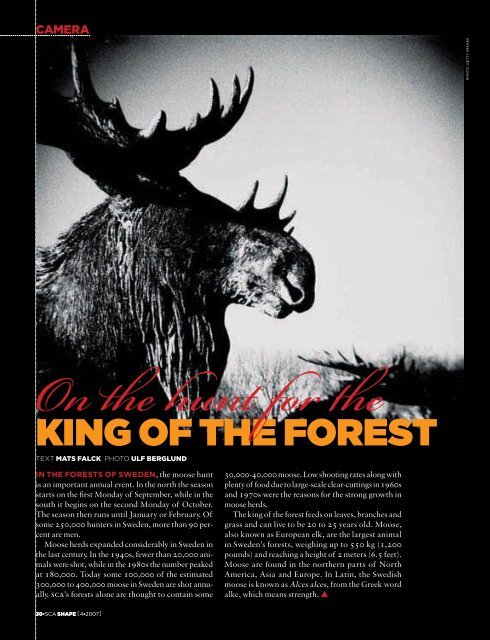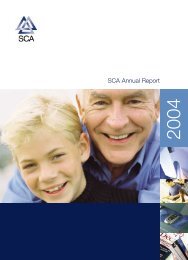SHAPE SHAPE SHAPE
SHAPE SHAPE SHAPE
SHAPE SHAPE SHAPE
You also want an ePaper? Increase the reach of your titles
YUMPU automatically turns print PDFs into web optimized ePapers that Google loves.
CAMERA<br />
On � e hunt for � e<br />
KING OF THE FOREST<br />
TEXT MATS FALCK PHOTO ULF BERGLUND<br />
IN THE FORESTS OF SWEDEN, the moose hunt<br />
is an important annual event. In the north the season<br />
starts on the fi rst Monday of September, while in the<br />
south it begins on the second Monday of October.<br />
The season then runs until January or February. Of<br />
some 250,000 hunters in Sweden, more than 90 percent<br />
are men.<br />
Moose herds expanded considerably in Sweden in<br />
the last century. In the 1940s, fewer than 20,000 animals<br />
were shot, while in the 1980s the number peaked<br />
at 180,000. Today some 100,000 of the estimated<br />
300,000 to 400,000 moose in Sweden are shot annually.<br />
sca’s forests alone are thought to contain some<br />
30*SCA <strong>SHAPE</strong> [3*2007] [4*2007]<br />
30,000-40,000 moose. Low shooting rates along with<br />
plenty of food due to large-scale clear-cuttings in 1960s<br />
and 1970s were the reasons for the strong growth in<br />
moose herds.<br />
The king of the forest feeds on leaves, branches and<br />
grass and can live to be 20 to 25 years old. Moose,<br />
also known as European elk, are the largest animal<br />
in Sweden’s forests, weighing up to 550 kg (1,200<br />
pounds) and reaching a height of 2 meters (6.5 feet).<br />
Moose are found in the northern parts of North<br />
America, Asia and Europe. In Latin, the Swedish<br />
moose is known as Alces alces, from the Greek word<br />
alke, which means strength. ▲<br />
PHOTO: GETTY IMAGES















